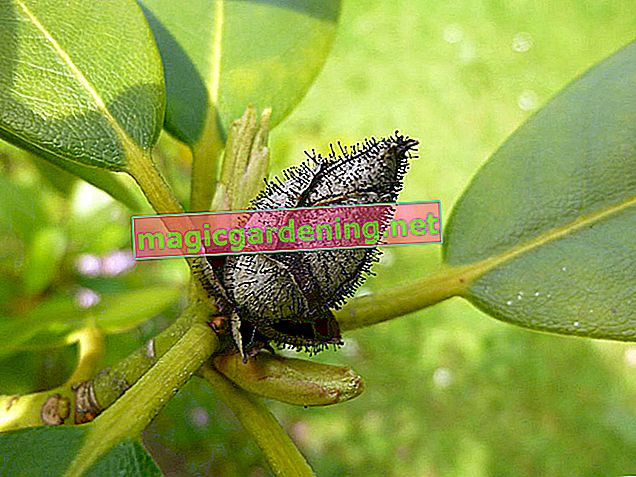
- Aphids
- Whiteflies
- Black Weevil Beetle
- Bed bugs
- Cicadas
Aphids suckle on young shoots
Aphids are found on young shoots. Their sucking deforms the leaves. The pest will then be visible at the latest. In addition, black sooty fungi attack the damaged leaves.
also read
- First select the correct rhododendron location, then plant
- Rhododendron earth is not just rhododendron earth
- Recognize and drive away peppermint pests
Moth whales sit and suckle on the underside of leaves
Moth whiteflies or white flies invade the undersides of the leaves en masse. When touched, they fly up immediately.
Countermeasures for lice:
Support the natural aphid killers in your garden. Such as wasps, ladybugs, ground beetles, hoverflies and lacewings. When using pesticides, look out for products that are gentle on beneficial insects.
Black weevil beetle wanders over the leaves at night
The dark colored, about one centimeter tall, dreaded weevil wanders over the leaves at night and nibbles off the edges. The larvae of the beetle pose a greater threat. They develop from the eggs in the ground and eat roots so that the plant dies in a short time.
Countermeasures for weevils and larvae:
Chemical measures are of little use because the beetle only comes at night. Spread rotten boards, tree stumps, or old roots between the plants. The bugs hide underneath and you can dispose of them in the morning.
On the other hand, the larvae in the soil can be successfully combated. Roundworms that are simply poured into the earth have proven particularly useful. Note that the roundworms need soil temperatures of at least 10-12 ° C and uniform soil moisture.
Bedbugs use rhododendrons as a breeding ground
The rhododendron net bug or skin bug lays its eggs on the underside of the upper leaves in late summer. The bugs cover their brood with a visible droplet of black-brown droppings. From May, wingless young bugs hatch. As adult, winged animals, they appear in July. Hardy rhododendron varieties with tomentose hairs on the undersides of the leaves are spared the bugs!
Countermeasures for bedbugs:
The best time to spray to control the larvae offspring is immediately after flowering. Make sure that the underside of the leaf is intensively wetted.
Cicadas let rhododendron buds die
What is grass green with noticeable red stripes on the back? The rhododendron cicadas. From September they lay their eggs in the buds. Dangerous side effect: They transfer the fungal spores of the bud tan. These penetrate the buds while the eggs are being laid. The dark colored buds do not fall off, but are covered with a veil of fungus in spring.
Countermeasures for cicadas: Not the fungus but the cicadas
can be eliminated successfully. Most effective by regularly spraying the underside of the leaves early in the morning. As long as the insects are still cold and inactive. Break out the dark, fungal buds from February onwards and dispose of them with household waste.
Tips & Tricks
When using spray, note that the liquid does not adhere well to the smooth rhododendron leaves. Add a few dashes of detergent to the spray to relieve the surface tension of the water.








